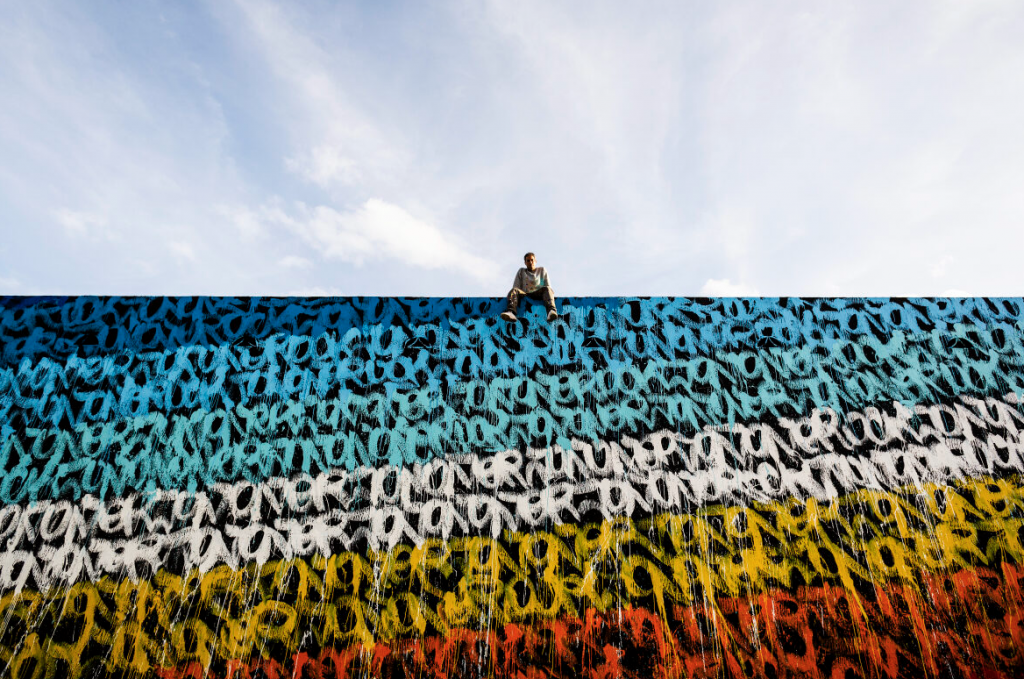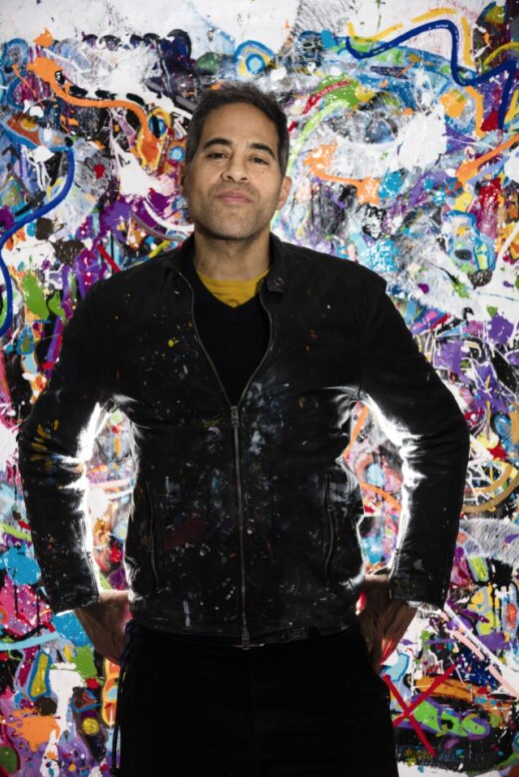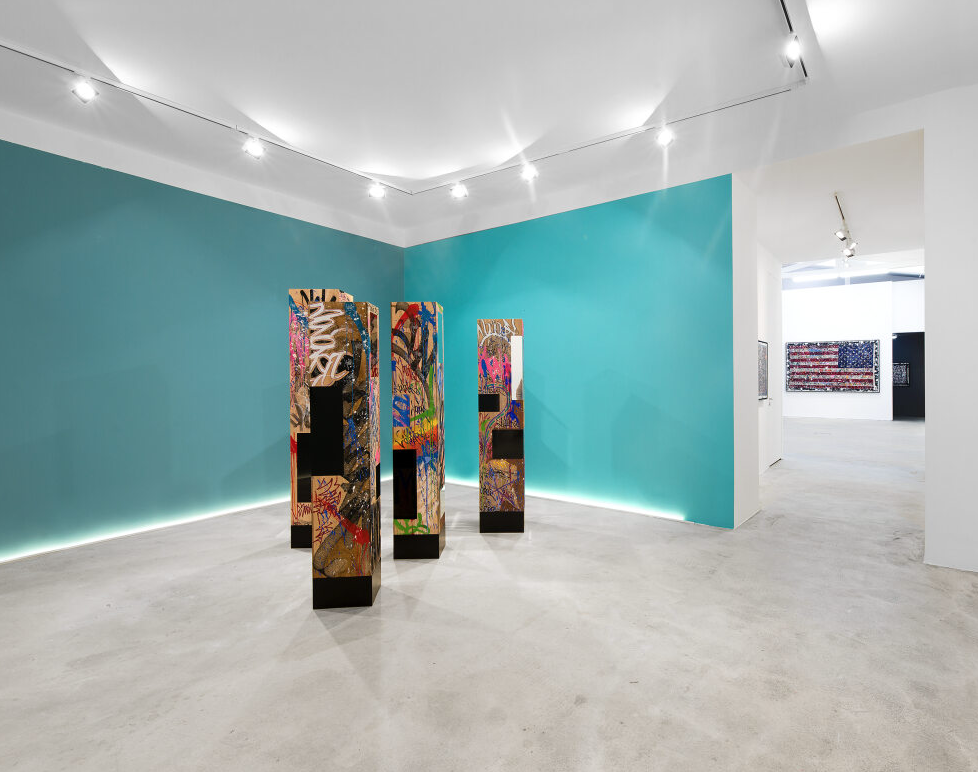#culture / #art & design
JonOne talks about the roots of freestyle painting
BY #legend
August 23, 2023
With roots in New York graffiti culture, self-taught American artist JonOne learned how to paint in the street. He explains to Dionne Bel how creation is about working without constraints according to your own rules

JonOne – aka john Perello – is always on the go. In just the first half of 2023, he has been to New York, Rio de Janeiro, São Paulo, Cartagena, Lisbon, Cape Town, Bangkok, Alabama and Miami. Soon he’ll be off again to Belgium, Morocco, Brazil and South Korea. Drawing or painting every single day, he insists that “there are no days off. That’s part of the game.”
Highly sought after by collectors, the 59-year-old artist born in New York of Dominican origin has worked long and hard to get to where he is today. An emblematic figure of the New York graffiti scene, he moved to Paris in 1987, where he currently lives and works.
After initially tagging his name infinite times on walls and subway cars, he wished to leave a more lasting mark and searched for a new type of complicity with those who appreciated his art, eventually making the transition to canvas and exhibiting in galleries and museums. Celebrated for his paintings that are explosions of pure joy and colour, the nonconformist refused to follow the rules and created his own wild style in his quest for freedom.

Born with a desire to express himself that can’t be extinguished, JonOne acknowledges that painting has been instrumental in helping him to find peace in his life – in fact, it’s the key to his happiness. Rather than the social or political engagement of most street art today, his work has always been egocentric in nature, focused on the self. More at ease expressing himself in abstract form rather than figurative, he describes his work as a private journal of his life recounting his personal experiences and above all an energy that he has been lucky enough to share with others.
After setting up a second studio in 2018 in the northern French industrial city of Roubaix that has been particularly welcoming of urban art, he has been invited by La Piscine museum for a solo show entitled La Tentation du Décor running until September 3, 2023.
Presenting approximately 200 pieces, the exhibition showcases an entire corridor filled with his pandemic drawings series from 2020 to 2023, his forays into the applied arts through collaborations with faience factory Gien, crystal manufacture Daum, fashion house Agnès b. and embroiderer Atelier Safrane Cortambert, and paintings from the 1990’s to present day.
Tell us about where you were born and raised, your upbringing and your parents.
I was born in Washington Heights in New York City, where graffiti started. They had the first corner writers’ bench and the first tags; it was like the mecca of graffiti. When I was growing up, I used to see all those tags everywhere. It was very associated with gangs and being antisocial, but I thought it was cool. My dad was a window trimmer and my mother ran Perello’s Boutique selling jeans and things like that. We were just getting by, but I had graffiti parents who were very supportive. My tags were all over the streets and people told my dad that his son was a bad person, but he bought me an architectural table, a lamp, a trash bin and a pack of paper even though we didn’t have a lot of money. I would spend my Friday and Saturday nights practising. They were always encouraging my art.
Describe your artistic language and philosophy.
What I’ve been doing lately is like a journal in time. My work is my relationship to my past: my early years in New York, all the adventures that I had there, then arriving in France and having two small children. I have to adapt to the reality of my life. I can’t live in the past. I have to confront some things now. Then there’s also the future because you don’t just work for the present. My approach to my paintings is a dialogue because I’m in the studio listening to music and trying to express all those things that are brewing inside me until my canvases feel free, which sometimes can be joyful and sometimes heavy. I told myself to make myself happy in life, I don’t care if I have money, I’m going to paint and make my life very joyful with yellows, oranges, pinks and purples, and make my life as colourful as my paintings. So that’s why when you see my paintings, they’re full of energy and they make you almost forget the reality of your own life.
Also see: Six exhibitions to check out
What is the “freestyle” aesthetic you invented?
The American system is very conservative. To get a job, you have to speak a certain way. When I speak in English, I sound a bit like a thug, and when you’re in the working world in New York, you have to change your language completely. You have to speak like a white man and dress like them: beige pants, dark brown belt, Top-Sider shoes, polo shirt. I felt I didn’t fit in. I was very constrained and I wanted to be free in everything I do.
When I started to paint, I didn’t want to have those same sorts of constraints as far as representing myself as a graffiti writer, a hip-hop guy or painting in a figurative way. I painted in the streets just to be free, so that’s why “freestyle” came along, which is you do whatever you want to do, as long as you express yourself and say something. So that search for freedom wasn’t by chance – it came from New York and breaking traditions. That’s the way my ideas of “freestyle” came into existence, which is the improvisation of colours, movement and energy in a poetic way.

Describe your exhibition, La Tentation du Décor, at La Piscine.
There’s a part focused on my drawings because I draw a lot – I’ve done thousands of drawings – and a part on how I’ve been able to adapt my style to different objects: fabric with Agnès b., Hennessy bottles, aeroplanes, Faïences de Gien vases and plates, carpets and all these things. And there’s another part that’s like a mini-retrospective with old canvases of mine and more recent ones. I’m very happy with the exhibition because it shows different moods and the diversity of my work.
After a career of over four decades, has it gotten easier to be an artist?
No, it’s gotten even more complicated because you always have something to deal with. Painting is a long road. There are people here now who walk with you a bit, but after they disappear, then you meet new people. But there’s one thing that doesn’t change: your passion for painting that you try to protect all the time because you know how hard you fought to have this passion despite people who want to tear you down, saying you’re nothing, you make too many canvases, you have to stop and calm down. They come into your life, give you money and think that you belong to them like the JonOne puppet. They are happy to see you rise, but the moment you do, they wait for only one thing: for you to fall. So you try to keep that little light on and never stop.
Also see: Audemars Piguet and the sound of music























































